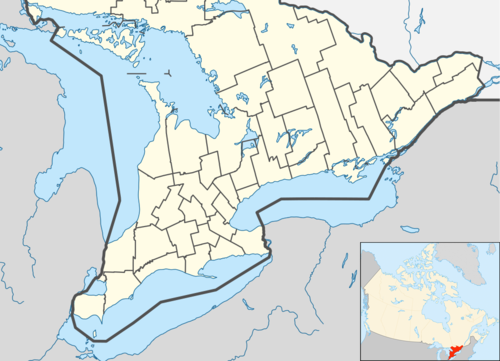Munsee-Delaware Nation
Munsee-Delaware Nation is a Lenape First Nations band government located 24 kilometres (15 mi) west of St. Thomas, in southwest Ontario, Canada. Known previously as the Munsee of the Thames, their land base is the 1,054 hectares (2,600 acres) Munsee-Delaware Nation 1 reserve, with the unincorporated community of Muncey (west from the Oneida Nation of the Thames) as their main community. The reserve is splintered into several non-contiguous areas, made up of individual lots within the Chippewas of the Thames reserve. As of January 2014, their registered population was 612 people, though only 148 lived on their own reserve.
Munsee-Delaware Nation 1 | |
|---|---|
| Munsee-Delaware Nation Indian Reserve No. 1 | |
 Munsee-Delaware Nation 1 | |
| Coordinates: 42°48′N 81°29′W | |
| Country | |
| Province | |
| County | Middlesex |
| First Nation | Munsee-Delaware |
| Formed | 1967 |
| Government | |
| • Chief | Alice Thomas |
| • Federal riding | Lambton—Kent—Middlesex |
| • Prov. riding | Lambton—Kent—Middlesex |
| Area | |
| • Land | 11.22 km2 (4.33 sq mi) |
| Population (2011)[1] | |
| • Total | 160 |
| • Density | 14.3/km2 (37/sq mi) |
| Time zone | UTC-5 (EST) |
| • Summer (DST) | UTC-4 (EDT) |
| Postal Code | N0L |
| Area code(s) | 519 and 226 |
History
Members of the Munsee branch of the Lenape (Delaware) nation arrived in the area in the eighteenth century. The Lieutenant-Governor, John Graves Simcoe, encouraged the Munsee to settle there although Chippewa were already established there. In 1819 the Chippewa of the Thames reserve was established, and in 1840 the Munsee and the Chippewa finally reached an agreement to share the land. In 1967 the Munsee portion became part of the current reserve, which was established by Order in Council.
Demographics
The Munsee-Delaware First Nation had a registered population of 524 in April 2004, of whom 163 lived on the reserve. By January 2011, the nation had a total registered population of 555, of whom 145 lived on the reserve.[2]
| Canada census – Munsee-Delaware Nation community profile | |||
|---|---|---|---|
| 2006 | |||
| Population: | 167 (% from 2001) | ||
| Land area: | 11.22 km2 (4.33 sq mi) | ||
| Population density: | 14.9/km2 (39/sq mi) | ||
| Median age: | 27.8 (M: 28.5, F: 26.5) | ||
| Total private dwellings: | 72 | ||
| Median household income: | |||
| References: 2006[3] earlier[4] | |||
Governance
Munsee-Delaware Nation's Chief and Council are elected officials who serve a two (2) year term of office. Elections are governed by their own Band Custom Election Code. Chief and Council are directly accountable to the band membership for the success of the Nation and the conduct of its affairs and for carrying out the community's mission and vision.
The history of Munsee-Delaware Nation elected Chief and Council are:
· 2014 / 2016 Term - Chief Roger Thomas, Head Councillor Aaron Dolson Jr., Councillor Ryan Peters, Councillor Rose Snake, Councillor Candy Thomas · 2012 / 2014 Term - Chief Patrick Waddilove, Head Councillor Rose Snake, Councillor Frank Cooper, Councillor Dean Snake, Councillor Leander Snake
→ Bi-election August 3, 2013 - Chief Roger Thomas
· 2010 / 2012 Term - Chief Patrick Waddilove, Head Councillor Rose Snake, Councillor -
Services
- Administration
- Community Centre (which provides ready access to health care and police services)
- Child Care Centre
- Ontario Works
External links
See also
- Moraviantown
- Christian Munsee
- Delaware People
- Delaware languages
- Munsee language
References
- "Munsee-Delaware Nation 1 community profile". 2011 Census data. Statistics Canada. Retrieved 3 June 2015.
- Indian and Northern Affairs Canada - First Nation Profiles: Registered Population Munsee-Delaware Nation Archived 2015-06-19 at the Wayback Machine
- "2006 Community Profiles". 2006 Canadian Census. Statistics Canada. March 30, 2011. Retrieved 2011-02-18.
- "2001 Community Profiles". 2001 Canadian Census. Statistics Canada. February 17, 2012.